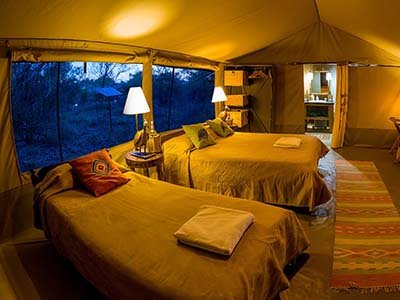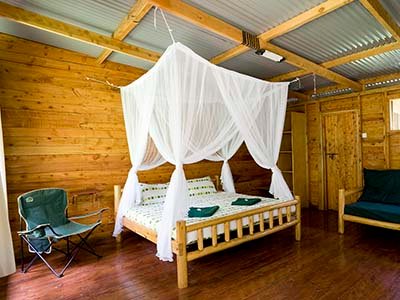Aberdare National Park
Aberdare National Park is situated approximately 100 kilometres north of Nairobi and spans a broad range of volcanic topography at elevations ranging from 2,000 metres (6,600 feet) to 4,000 metres (13,000 feet).
The Aberdare National Park covers approximately 766 square kilometres, was created in May 1950 and forms part of the Aberdare Mountain Range. In 1884, the explorer Joseph Thompson gave the Aberdare Ranges their current name, naming them after Sir George Aberdeen, who was the president of the Royal Geographical Society at the time.
The park has a variety of topographies, from deep ravines with streams, rivers, and waterfalls to high altitudes up to 4,000 metres (13,000 feet) above sea level.
The most well-known incident involving Aberdare National Park is when Princess Elizabeth discovered she was the Queen there in 1952 after learning of her father King George VI’s death while visiting the Treetops Hotel.
Wildlife in Aberdare National Park

The protected area is home to many species of animals, including lions, leopards, hyena, African elephants, East African wild dogs, giant forest hogs, bushbucks, mountain reedbucks, waterbucks, Cape buffalo, sunis, side-striped jackals, elands, duikers, olive baboons, black and white colobus monkeys, and sykes monkeys. Rarer sightings include those of the Mountain bongo which is a shy forest antelope endemic to the Aberdares and Mount Kenya and the African golden cat. The upper moorlands are home to species like the common eland and serval.
More than 250 species of birds, including the endangered Aberdare cisticola, Jackson’s spurfowl, sparrowhawk, African goshawk, African fish eagle, sunbirds, and plovers, may be found in the Aberdare National Park. It is also home to a significant population of endangered species White rhinos and eastern black rhinos.
Birds and Birdwatching in Aberdare National Park.
- If you want to see a wide range of birds, the months of March through May and October through December are your best bet. Because of the increased precipitation, the park’s forests and grasslands are at their most verdant and diverse during this time of year.
- Birdwatching is popular in the park from June to September, which coincides with the dry season. The birds are easier to spot at this time of year because they congregate near water sources due to the dry weather.
- Birdwatching is sometimes more enjoyable at certain times of the day. The best times to watch birds are early in the morning or late in the afternoon when they are most active.
People and Culture Encounters of the Park
The major tourism Activities in the park.
- Gaming drives: Visitors may go on game drives, which are safari-style excursions of the park. Among the park’s many animals are elephants, leopards, and rhinoceroses, and game drives are a fantastic opportunity to for game viewing offered by safari tour companies or accommodation providers.
- Nature Walks: Hiking routes and walkways of varying lengths and difficulties may be found throughout the park. Hiking is a fantastic opportunity to get close to the park’s animals and discover the park’s many ecosystems, such as its woods and grasslands.
- Birdwatching: Many raptor species, including eagles, hawks, and vultures, make their home at Aberdare National Park. Birdwatching is a common pastime for park visitors, and there are numerous great spots to do it.
- Cultural encounters: The park is situated in a historically significant region, and visitors may enrich their understanding of local culture by participating in a variety of cultural activities. Village tours, native dance performances, and informative discussions are all possibilities.
- Recreational activities: Recreational amenities including swimming pools, tennis courts, and spa facilities are provided by a few of the lodges and hotels in the park.
Accommodation in Aberdare National Park
Different kinds of accommodation are available for park visitors, including the Tree lodge also known as the Ark (constructed in the style of Noah’s Ark), three self-help banda sites, eight exclusive campsites, and public camping in the moorland.
Five picnic areas are available as well. And these provide excellent opportunities to see animals at night may be found at Treetops and The Ark. Elephants, Cape buffalo, and rhinos may be seen visiting the waterholes. At Mweiga and Nyeri, the park also has two airstrips.
Park admission and fees
From 6:00 am to 7:00 pm every day, the park is accessible. Visitors are turned away after 6:15 p.m. and entry is not permitted on foot.
Only smart cards loaded at the main entrance are permitted entry into the park.
Frequently Asked Questions
How much time does one need to explore the key attractions in the Park?
The amount of time you need to explore the key attractions in Aberdare National Park will depend on your interests and the activities you want to do. If you are planning to participate in a variety of activities and see as much of the park as possible, you may want to allow at least 2-3 days.
There are several activities to do in the park, including guided tours, game drives, hiking, and birdwatching. The park is also home to several lodges and hotels, which offer a range of amenities and recreational activities.
If you are interested in seeing the wildlife, you may want to allow some time for game drives, which can take several hours. You may also want to allow some time for hiking, which can take anywhere from a few hours to a full day, depending on the trail and your fitness level.
Overall, the amount of time you need to explore the key attractions in Aberdare National Park will depend on your interests and the activities you want to do. It is a good idea to plan your trip in advance and allow enough time to see and do everything you want.
When is the ideal time of year to go to the park if I want to go on a safari?





